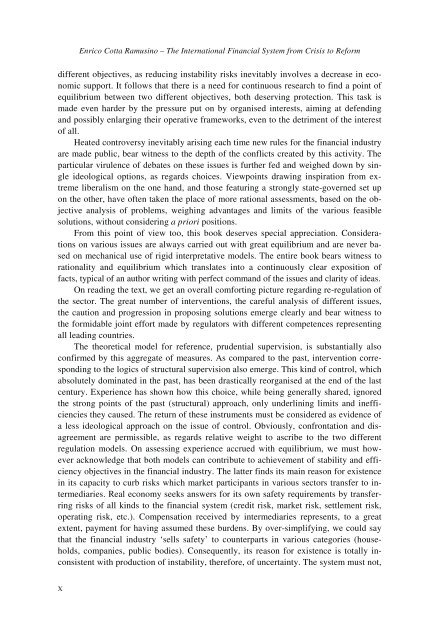PP Enrico Cotta Ramusino - Pavia University Press
PP Enrico Cotta Ramusino - Pavia University Press
PP Enrico Cotta Ramusino - Pavia University Press
Create successful ePaper yourself
Turn your PDF publications into a flip-book with our unique Google optimized e-Paper software.
<strong>Enrico</strong> <strong>Cotta</strong> <strong>Ramusino</strong> – The International Financial System from Crisis to Reform<br />
different objectives, as reducing instability risks inevitably involves a decrease in economic<br />
support. It follows that there is a need for continuous research to find a point of<br />
equilibrium between two different objectives, both deserving protection. This task is<br />
made even harder by the pressure put on by organised interests, aiming at defending<br />
and possibly enlarging their operative frameworks, even to the detriment of the interest<br />
of all.<br />
Heated controversy inevitably arising each time new rules for the financial industry<br />
are made public, bear witness to the depth of the conflicts created by this activity. The<br />
particular virulence of debates on these issues is further fed and weighed down by single<br />
ideological options, as regards choices. Viewpoints drawing inspiration from extreme<br />
liberalism on the one hand, and those featuring a strongly state-governed set up<br />
on the other, have often taken the place of more rational assessments, based on the objective<br />
analysis of problems, weighing advantages and limits of the various feasible<br />
solutions, without considering a priori positions.<br />
From this point of view too, this book deserves special appreciation. Considerations<br />
on various issues are always carried out with great equilibrium and are never based<br />
on mechanical use of rigid interpretative models. The entire book bears witness to<br />
rationality and equilibrium which translates into a continuously clear exposition of<br />
facts, typical of an author writing with perfect command of the issues and clarity of ideas.<br />
On reading the text, we get an overall comforting picture regarding re-regulation of<br />
the sector. The great number of interventions, the careful analysis of different issues,<br />
the caution and progression in proposing solutions emerge clearly and bear witness to<br />
the formidable joint effort made by regulators with different competences representing<br />
all leading countries.<br />
The theoretical model for reference, prudential supervision, is substantially also<br />
confirmed by this aggregate of measures. As compared to the past, intervention corresponding<br />
to the logics of structural supervision also emerge. This kind of control, which<br />
absolutely dominated in the past, has been drastically reorganised at the end of the last<br />
century. Experience has shown how this choice, while being generally shared, ignored<br />
the strong points of the past (structural) approach, only underlining limits and inefficiencies<br />
they caused. The return of these instruments must be considered as evidence of<br />
a less ideological approach on the issue of control. Obviously, confrontation and disagreement<br />
are permissible, as regards relative weight to ascribe to the two different<br />
regulation models. On assessing experience accrued with equilibrium, we must however<br />
acknowledge that both models can contribute to achievement of stability and efficiency<br />
objectives in the financial industry. The latter finds its main reason for existence<br />
in its capacity to curb risks which market participants in various sectors transfer to intermediaries.<br />
Real economy seeks answers for its own safety requirements by transferring<br />
risks of all kinds to the financial system (credit risk, market risk, settlement risk,<br />
operating risk, etc.). Compensation received by intermediaries represents, to a great<br />
extent, payment for having assumed these burdens. By over-simplifying, we could say<br />
that the financial industry ‘sells safety’ to counterparts in various categories (households,<br />
companies, public bodies). Consequently, its reason for existence is totally inconsistent<br />
with production of instability, therefore, of uncertainty. The system must not,<br />
X
















